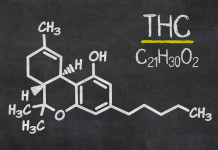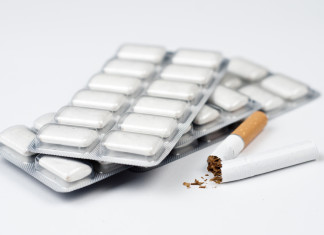“Well, at least pot doesn’t cause cancer!”
You’ve probably heard that line - and it’s probably wrong. Both marijuana and tobacco are hazardous to your health.
These drugs are “harvested” in the same way: You dry out the plant, chop it up, set it on fire, and inhale the smoke. Silly as that sounds, a lot of people do it, because both products give the user a feeling of euphoria.
Nicotine, the Drug
The nicotine in tobacco smoke stimulates brain cells and speeds the heart rate, creating a state of alertness. At the same time, it relaxes the muscles. At higher doses, nicotine becomes a depressant instead of a stimulant. The more you use nicotine, the more you need to get the same result.
These effects are like those of cocaine. In fact, when volunteers in a laboratory were given injections of nicotine and cocaine of equal strength without being told which was which, they were not able to tell the difference between the two drugs. U.S. Surgeon General C. Everett Koop declared in 1988 that nicotine is just as addictive as cocaine or heroin.
Ninety percent of adult smokers started in their teens, apparently to “go along with the crowd.” Nine of 10 teenagers who smoke said in a survey that they would give up smoking later in life. But only 40 percent of smokers who try to quit succeed permanently, and many don’t even try. It isn’t an easy process: A heavy smoker who stops smoking may suffer headaches, tremors, and an almost irresistible craving for the drug. Although physical symptoms last only a few days, former smokers may experience cravings for a long time.
The Marijuana “High”
The marijuana “high” is caused by chemicals called cannabinoids, especially delta-9 tetrahydrocannabinol, or THC, which interferes with signals between nerve cells, causing jumbled thoughts and distortions of perception. Users say marijuana makes their senses sharper and makes them more creative. In reality, the user becomes illogical, forgetful, and clumsy. Higher doses cause irritability, anxiety, and even hallucinations. The effects from a single use can last two to four hours, and traces of THC remain in the body for a week or longer. THC can be detected in urine for up to 30 days in chronic abusers.
Marijuana is easier to give up than tobacco, but a heavy smoker who stops still experiences withdrawal symptoms, including insomnia, sweating, anxiety, nausea, and tremors.
Marijuana was first used in the United States around the turn of the century. Police officers believed it was a cause of crime, and by 1937 every state had laws banning marijuana, some with harsh prison sentences or even the death penalty as punishment. In the early 1970s, most laws were scaled down and now carry a significantly lesser penalty. A movement to make marijuana legal was halted as medical research began to prove that the drug is far from harmless.
Both Have Tar
Burning any plant material creates hundreds of complex organic chemicals. When separated from smoke, they form a black, gummy mass called “tar.” Many of the chemicals in tar are known to cause cancer.
Tobacco and marijuana smoke contain about the same amount of tar. But the damage caused to marijuana smokers’ lungs in only a few months’ time is similar to what happens in tobacco smokers after many years - even though marijuana smokers use fewer cigarettes. One reason may be that marijuana smokers inhale very deeply and hold the smoke in their lungs longer. Another may be that THC alone can destroy cells. It attaches to cell membranes and causes cells to divide in unnatural ways.
Tiny particles of tar also irritate the lungs and airways, just as blowing sand can scour paint off a wall. Along with lung cancer, the irritation can cause bronchitis (inflammation of the air passages leading to the lungs) and emphysema, in which the lungs no longer transfer enough oxygen to the bloodstream.
Carbon Monoxide in Common
Both marijuana and tobacco smoke also contain carbon monoxide, the same poisonous gas found in automobile exhaust. Marijuana smokers have much more carbon monoxide in their blood than do tobacco smokers, again because they inhale more deeply. Carbon monoxide replaces oxygen in the bloodstream, forcing the heart to pump harder to send enough oxygen through the body just at a time when the heart muscle itself is receiving less oxygen than it needs. This may explain the statistics that show tobacco smokers are more likely to have heart attacks. Another reason may be that tobacco smoke makes cholesterol more likely to form deposits on the walls of arteries; heart attacks happen when arteries that supply the heart muscle become clogged.
Possibly because carbon monoxide deprives the fetus of oxygen, women who smoke either tobacco or marijuana during pregnancy are more likely to have low-birth weight babies who may grow up to have health and intelligence problems.
There’s More
Laboratory experiments have shown that marijuana interferes with the growth of cells that are needed in the body’s system for fighting bacteria, viruses, and cancer.
The most dramatic difference between marijuana and tobacco may be in the effect marijuana has on the brain and nervous system. Some people who smoke marijuana heavily over a long period of time become confused, apathetic, and forgetful. Some have delusions or become overly aggressive or paranoid. One possible explanation is that THC widens and clogs the junctions between nerve cells, especially in parts of the brain that deal with memory and emotion. There is also some evidence that THC destroys brain cells.
Various studies, some still controversial, have associated tobacco smoking with leukemia, osteoporosis (weakening of the bones in elderly people), breast and cervical cancer, cancer of the pancreas, Alzheimer’s disease, gum disease, and even excessive aging and wrinkling of the skin. (Marijuana may also contribute to some or all of these, but the research as yet is inconclusive.)
Asking whether one of these drugs is “safer” than the other is like asking whether it’s safer to jump off a tall building or stand in front of a speeding freight train. The impact is the same.
































